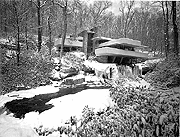| back to: Chapter 8
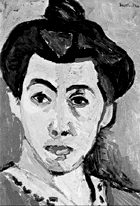
Madame Matisse (The Green Stripe)
Fauve
oil on canvas
1905
by Henri Matisse 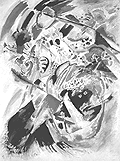
Painting Number 201
Blue Rider Group
oil on canvas
1914
by Vassily Kandinsky
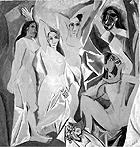 Les Demoiselles d'Avignon
Cubism
oil on canvas
1907
by Pablo Picasso
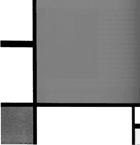 Composition with Red, Blue, and Yellow
De Stijl
oil on canvas
1930
by Piet Mondrian
 Bauhaus-Dessau, Germany
International Style
architecture
1925
by Walter Gropius
| Modern Art before 1945
MODERNISM
Modernism was a movement that started around 1880 and ended in 1980. It was characterized by its theoretical approach to art. "Art for art's sake" was a term which exemplified this movement because it basically said that art should be examined further to find out more about itself. The Modernists worked on theories of color, spirituality, universality, psychology, perception and the idea behind the art sometimes became more important than the image produced.
-most early 20th Century art movements were centered around a set of rules called manifestos. These manifestos created common ground and similar ideas for a group of artists to concentrate on.
-worked from ideas in psychology like Faber Birren's Psychology of Color. Birren found that people reacted differently when exposed to different colors. For instance, red made people hungry; blue was a calming color; etc.
the Fauves
-means "wild beasts" in French, referring to use of wild color and flat planes
-associated with the work of Cezanne
Henri Matisse
-used flat planes and bright vivid color. He was most interested in planes.
Portrait of Mdme. Matisse (the Green Stripe), 1905, oil on canvas, 16"x 12"
-used light that is reflected from different sources
-complementary colors are used
-portrait of Matisse1s wife
Vassily Kandinsky
-believed that colors had a spiritual quality and that sounds could be associated with particular colors
-believed that good art was a reflection of good moral character in an artist.
Painting Number 201, 1914, oil on canvas, 5'4"x 4'
-based on a "symphony of colors"
-used abstract lines and shapes
The Futurists
-believed in the positiive effects of industrialization in the Western World
-in their manifesto, they included support for WWI, which they thought would be a great cleansing and would end war forever
Umberto Boccioni, Unique Form of Continuity in Space, bronze sculpture, 1913.
Cubism
-was developed as a way to show all sides of an object in a two-dimensions
-developed by Georges Braque but made most public by Picasso
Picasso
-Spanish artist who worked in expressionist and cubist movements

Guernica * Cubism * oil on canvas * 1937 * by Pablo Picasso
Les Demoiselles d'Avignon, 1907, oil on canvas, 8'x 7'8"
-influence from African masks
-picture of prostitutes in Avignon, France done in harsh, primitive way.
Three Musicians, 1921, oil on canvas, 6'7"x 7'3"
-flattened abstracted forms
-arranged in rhythmic patterns
-slight diagonals add to rhythms
Guernica, 1937, oil on canvas, 11'6"x 25'6"
-painting memorializing first saturation bombing of a civilian area
-Picasso stipulated that the painting not be returned to Spain until democratic rule was restored
DE STIJL (the style)
This abstractionist movement was based in the idea that a "universal" aesthetic be produced. The members of the movement abstracted the world by using vertical lines (man) and horizontal lines (the horizon) to produce a grid. From their perspective, they are creating a form of art that has no basis in any other aesthetic tradition, i.e., African, Asian, etc.. Members of the movement include Piet Mondrian and Theo Van Doesburg, both Dutch artists.
the Bauhaus
-a school in Dessau, Germany that was founded with the intention of creating a universal International Style. The basis for this aesthetic idea was taken from the use of new materials like glass, metal, concrete, etc. The term "form follows function" was used to describe the importance of the use of an item over its aesthetic beauty. The use had to be the most important element, then the beauty of the object would follow.
-this school worked in architecture, art, and all facets of design. The building was designed by Walter Gropius. |
|
|
